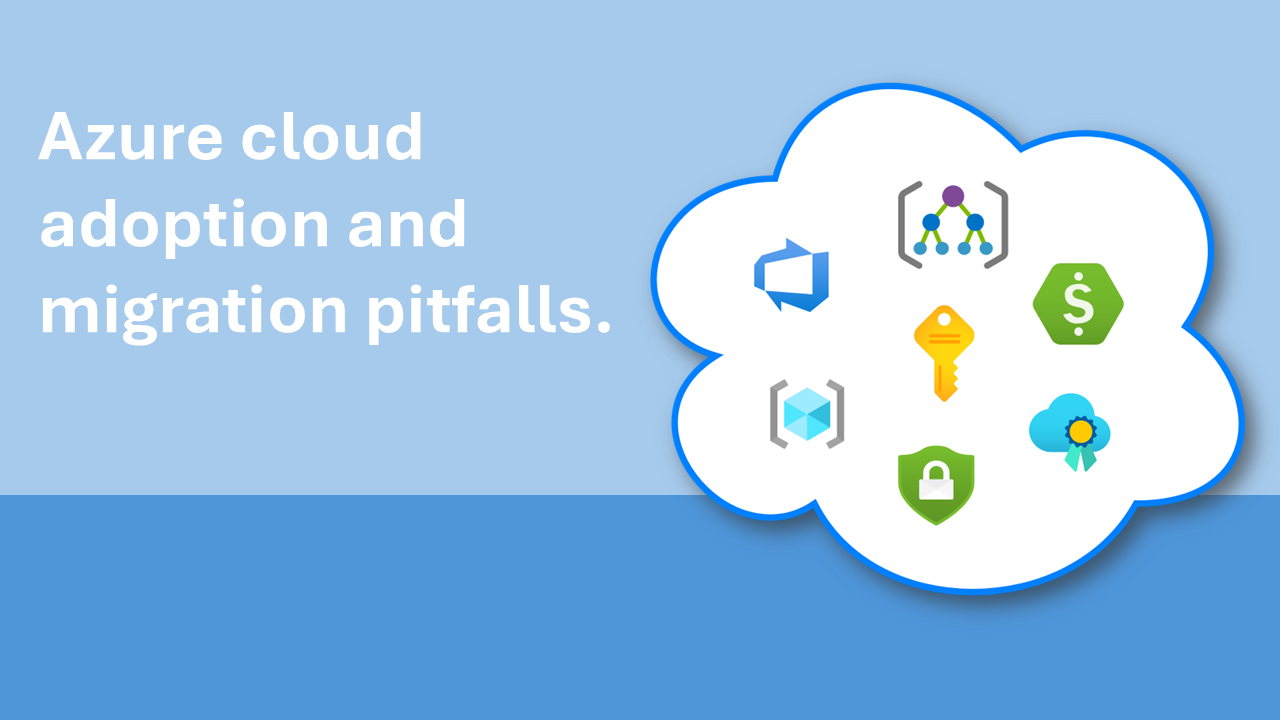Azure cloud adoption and migration pitfalls

Whether you are just starting out in Azure, running many production workloads on a full Azure landing zone architecture, looking to migrate resources from on-prem to Azure or want to improve your hybrid cloud environment each of these phases comes with its set of challenges. In this article I will highlight some common pitfalls you can avoid in your cloud journey.
5 common pitfalls for Azure cloud adoption or migration projects
- Lack of strategy and planning
- Insufficient governance and security measures
- Overcomplicated architecture
- Poor cost management
- Inadequate workload assessment and prioritisation
1. Lack of strategy and planning
A cloud adoption journey can be a costly and time consuming exercise, with the decisions made early on having a lasting impact on how secure, maintainable and efficient your Azure environment will be. This can sometimes keep us in the planning phase for months on end and leave us unable to pull the trigger on starting the cloud adoption journey. On the other side of the spectrum many organizations dive into Azure adoption without a clear strategy or comprehensive plan. This can lead to disorganized and inefficient implementations. It’s crucial to define clear objectives, assess requirements, and align the migration with business goals before beginning.
In order to avoid this pitfall Microsoft has developed the Microsoft Cloud Adoption Framework for Azure. This framework describes a comprehensive set of best-practices to help you on the cloud journey. When planning your adoption journey also budget time and money for educating your team.
2. Insufficient governance and security measures
Despite security and governance being a core advantage of cloud landing zones, it’s often overlooked or inadequately addressed during implementation. Organizations sometimes fail to implement robust security measures, leaving themselves vulnerable to data breaches and compliance issues. It’s essential to integrate strong security practices from the outset, rather than treating them as an afterthought.
Security and governance in the cloud can be a daunting topic, for this reason educating yourself and your team is crucial. Next to getting savvy on security, Microsoft also provides us with detailed documentation and tools when it comes to security. Using built-in Azure Policy initiatives which can be deployed at a Management Group level can ensure your Azure resources remain compliant with best-practice security guidelines. For example the Microsoft cloud security benchmark
3. Overcomplicated architecture
A common mistake is overengineering the cloud landing zone or migration process. This complexity can lead to increased maintenance efforts, security vulnerabilities, and difficulty in scaling. Organizations should opt for simplicity where possible, adopting well-architected patterns and leveraging Azure-native services. Microsoft provides us with the Azure landing zone as a reference architecture for your Azure environment.
4. Poor cost management
Without proper cost management, cloud expenses can quickly spiral out of control. Many organizations fail to plan for future growth and cost optimization. This oversight can lead to unexpected expenses as cloud usage grows. It’s important to leverage Azure Cost Management tools, such as Budgets and Cost Alerts and regularly review and optimize cloud spend.
5. Inadequate workload assessment and prioritisation
One of the most common mistakes is not properly assessing and prioritizing workloads for migration. Organizations often fail to identify which applications are suitable for the cloud or attempt to move everything at once without considering dependencies or criticality. This can lead to compatibility issues, performance problems, and unnecessary complexity.
Start with setting down the Azure Landing Zone and handle your migration in a repeatable and agile process. When assessing on-prem to Azure migrations, consider hybrid connectivity between your current environment and your Azure environment for interim connectivity between dependent workloads.
Conclusion
Azure adoption or migration can be a daunting process, but starting with a secure, scalable and well-governed Azure landing zone can make the adoption journey much smoother. If you are facing issues with your current Azure environment in terms of scalability, security or governance, it is never to late to get a fresh start and configure your Azure landing zone.